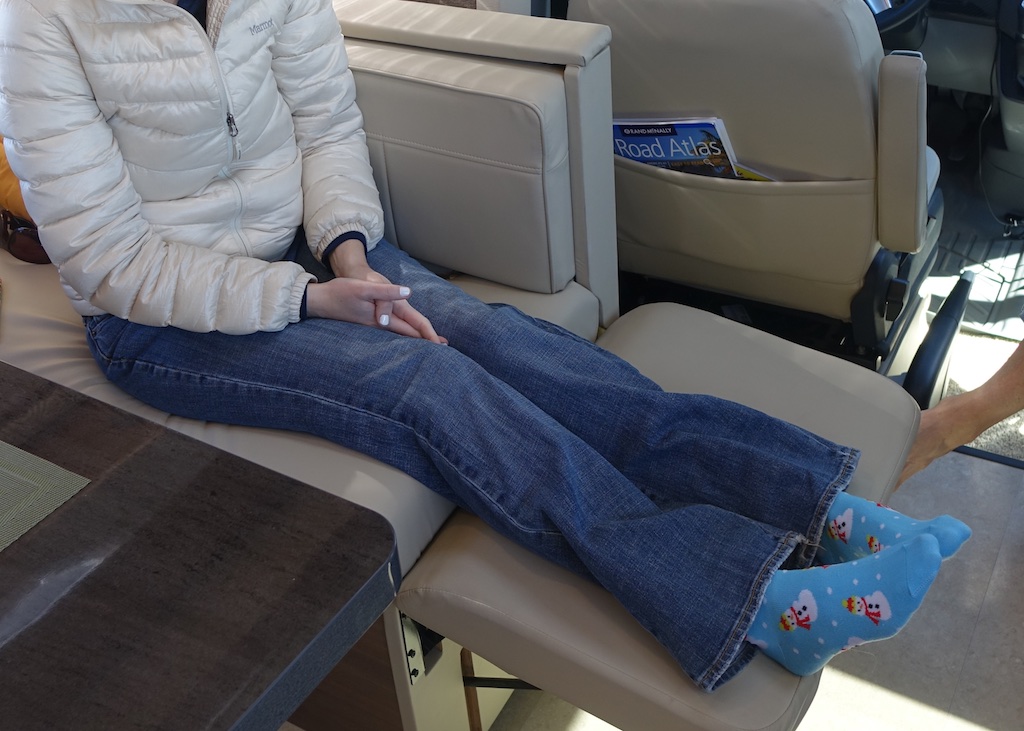
The Finest Class C on the Road
When we bought our first Navion our small collection of RV friends welcomed us into this new circle of adventure with the admonition, "you're next one will be even bigger." Their prediction was true, sort of.
In 2015 we bought a new Navion which was exactly the same size as our previous one, but as our friends predicted, larger both in living space and storage. I'll deal with that contradiction shortly, but first, before the reviewing begins, here's a little context.
Background
My wife Terry and I bought our first Navion in late 2012. It was a 2013 model V which was a brand new floorplan featuring a mid-coach bath and twin beds in the back. We never owned a motorhome before, but happily dived into the experience. In two years we traveled over 40,000 miles in the Navion spending about eight of those months living in it. Along the way, we developed some great friendships with Winnebago and ultimately I have found myself happily working with the company as the editor of this blog.
Now unlike traditional reviews where a writer gets a coach to drive for a few days or a week and then returns it to the dealer, we wrote a check for OUR Navion. The only difference the second time around was that, given my relationship with Winnebago, we were able to try out a few ideas that weren't currently offered (many are now). With a little extra cost for us, and some help from the design team and customer service, we added some features that we think would be nice upgrades in the future.
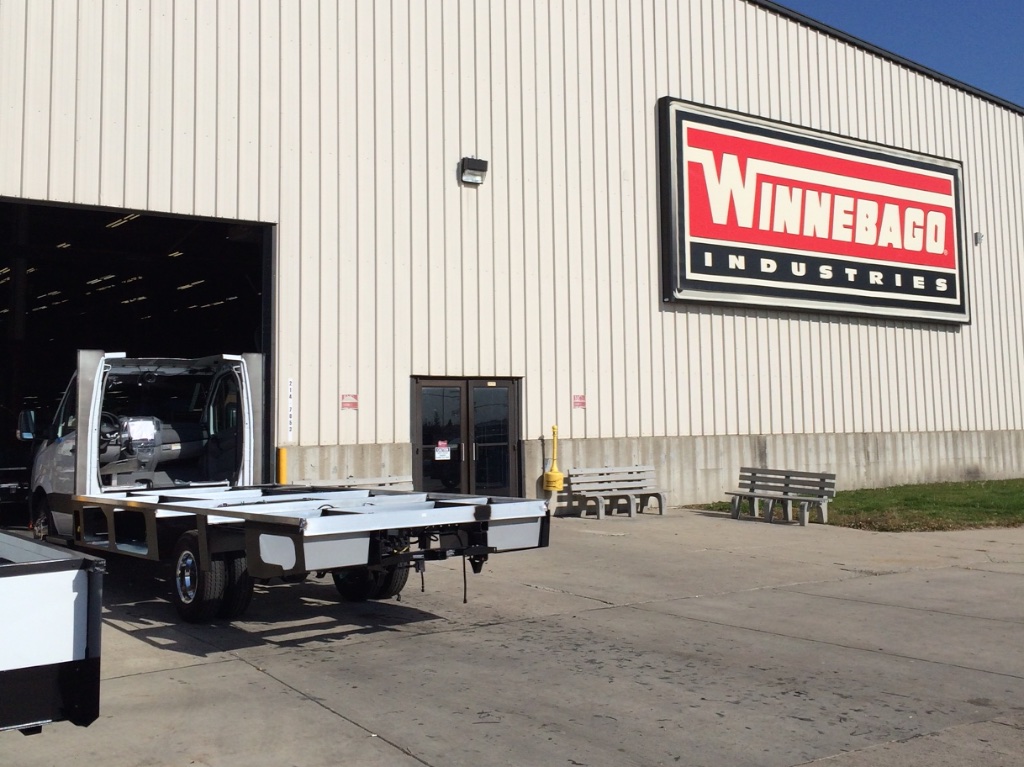 A Navion is born. With the chassis frame in place, our Navion starts it's journey through "Big Bertha" to be assembled.
A Navion is born. With the chassis frame in place, our Navion starts it's journey through "Big Bertha" to be assembled.
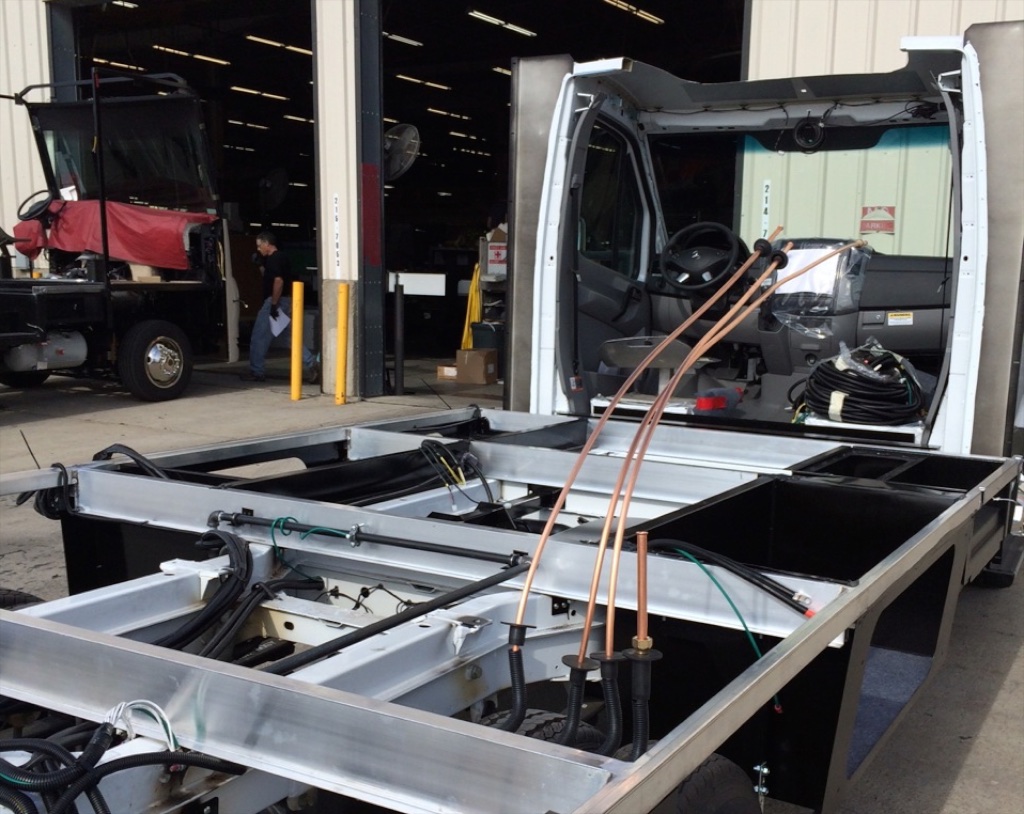 Before it goes into the factory, the plumbing and wiring harnesses are installed.
Before it goes into the factory, the plumbing and wiring harnesses are installed.
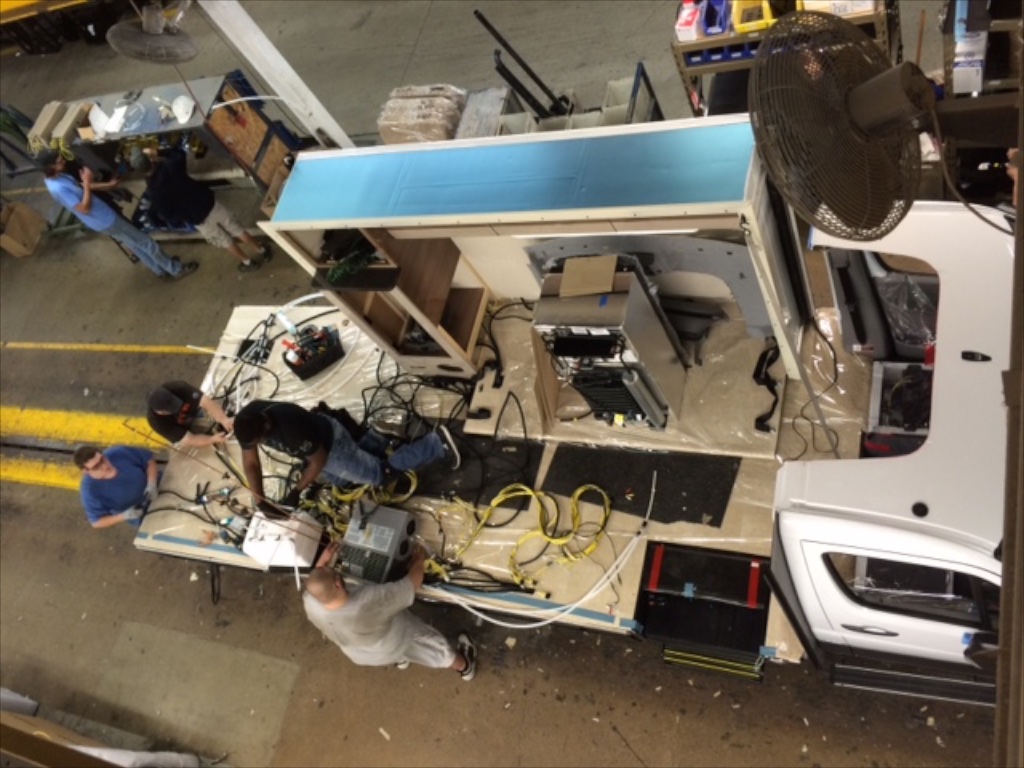 The slide is on! Look closely and you'll see the furnace and hot water heater being installed.
The slide is on! Look closely and you'll see the furnace and hot water heater being installed.
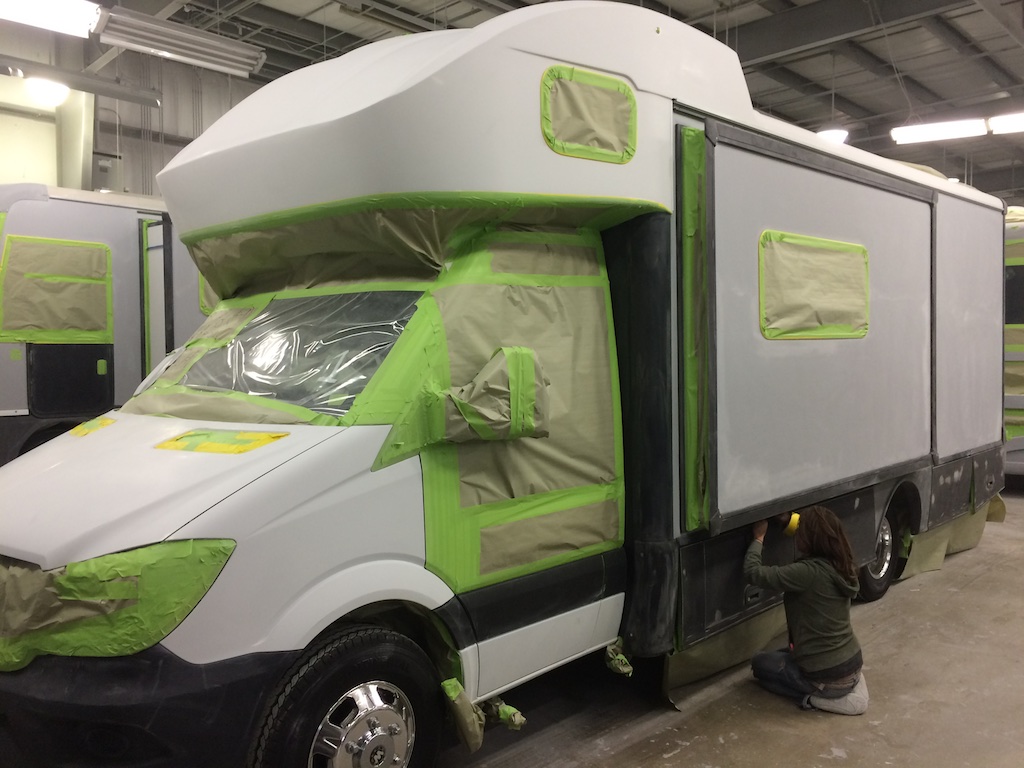 All assembled and ready for paint. In the span of about seven days, 18 people will be involved in the painting process.
All assembled and ready for paint. In the span of about seven days, 18 people will be involved in the painting process.
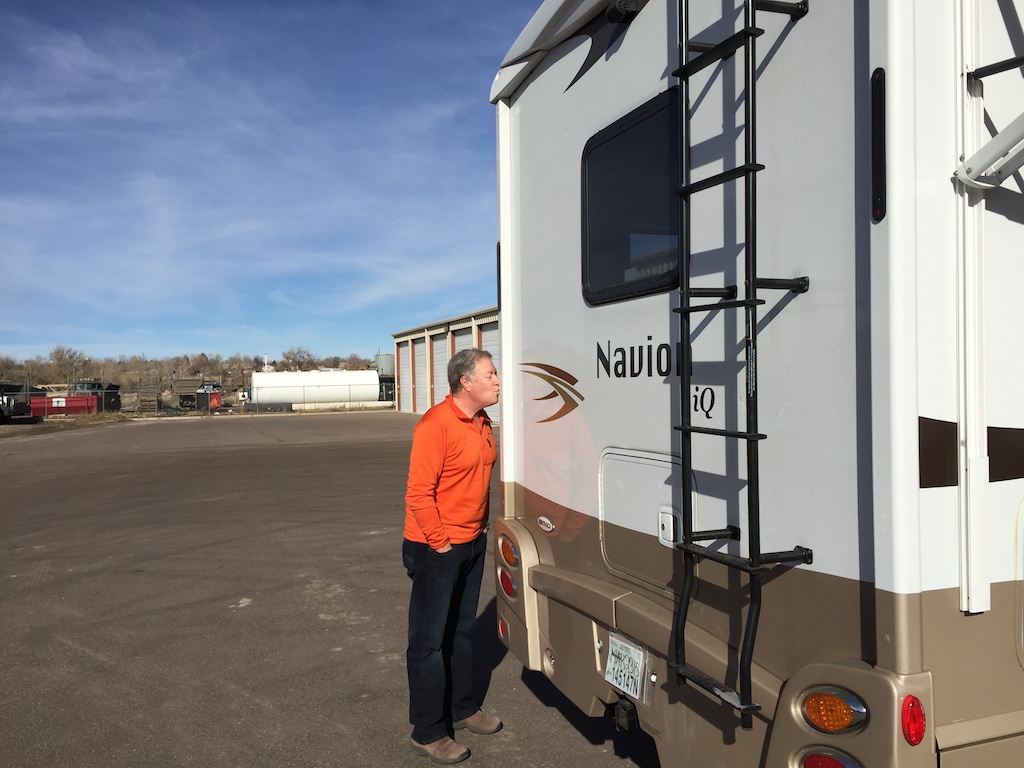 Don says goodbye to our well-traveled 2013 Navion V.
Don says goodbye to our well-traveled 2013 Navion V.
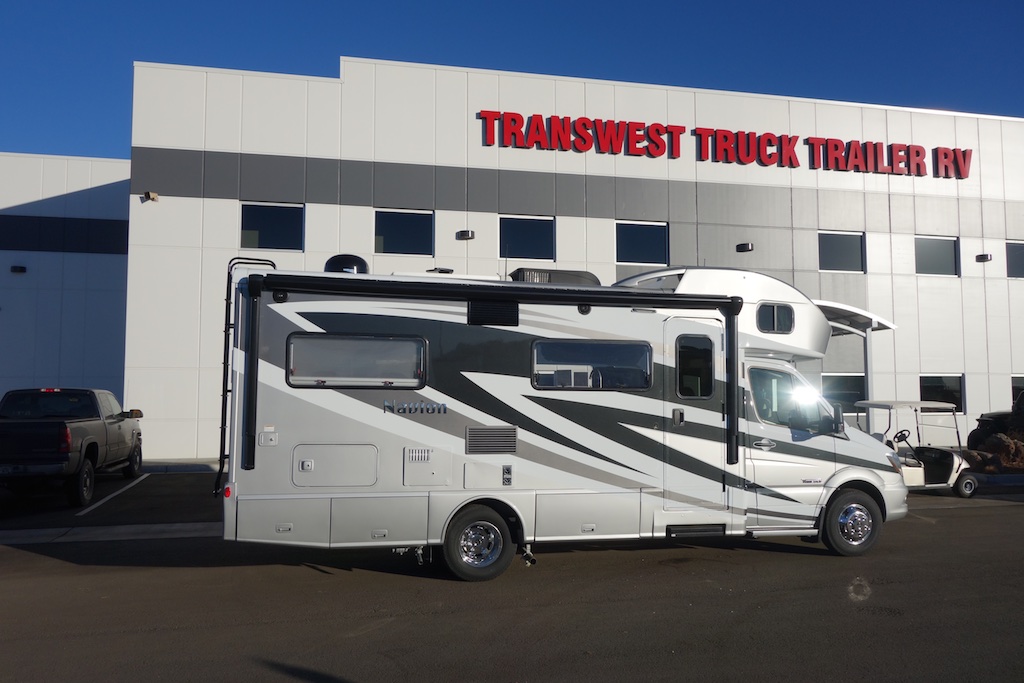 Day one. We take delivery at our dealer, Transwest, just north of Denver.
Day one. We take delivery at our dealer, Transwest, just north of Denver.
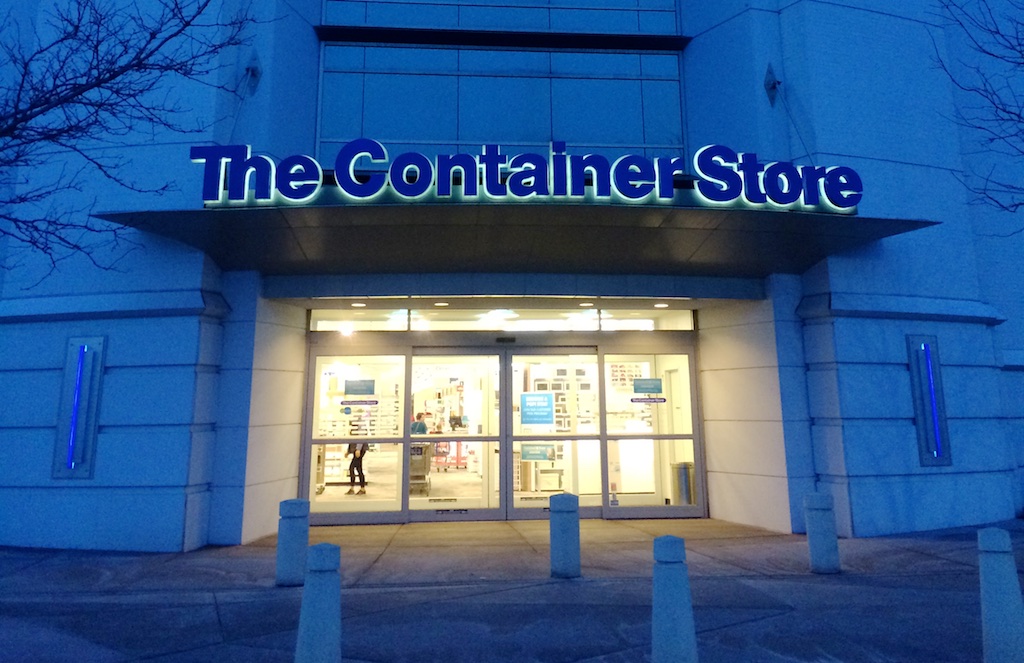 Next stop. Parking the Navion in front of the Container Store for two hours of trying out various storage solutions.
Next stop. Parking the Navion in front of the Container Store for two hours of trying out various storage solutions.
 Starting off right. A very thoughtful gift from Transwest including a surprisingly good Merlot labeled "Happy Camper."
Starting off right. A very thoughtful gift from Transwest including a surprisingly good Merlot labeled "Happy Camper."
 Entering the Texas Panhandle. For our first road test, we drove from Denver to Key West and spent 5,200 miles and a month traveling in the Navion. We had it in below freezing weather and in warmer temps that allowed us to test every system. And now, after 30,000 miles we've had one minor repair.
Entering the Texas Panhandle. For our first road test, we drove from Denver to Key West and spent 5,200 miles and a month traveling in the Navion. We had it in below freezing weather and in warmer temps that allowed us to test every system. And now, after 30,000 miles we've had one minor repair.
Changes big and small
In my tech life, I'm often asked by friends about when should they consider upgrading their hardware and software. Like tech, with every new year, the changes in motorhomes is usually incremental. The differences in the 2015-17 models will be very evident to owners of 2011 and older models. Yet even in two years, since we bought our 2013 V, Winnebago had made some significant and much-appreciated changes to the line.
The Mercedes Chassis
Mercedes updated the Sprinter chassis in 2014 and outside of front grill changes, there's seems to be very little difference from our 2012 chassis. However, Winnebago is now ordering the chassis configurations with steering wheel controls. As part of the steering wheel package, there's a change in the dashboard with a much nicer LED-like display showing engine messages. You access the message center with a button cluster on the left slide of the wheel. And, for me, there was a lot to like with this new arrangement.
First of all, you don't need to reset the outside temperature display. Once it's set. It remains there. Stepping through the dashboard menus you can check oil level (when stopped) and monitor engine temperature. One really nice feature is the estimate of how many miles until empty. This is only a rough gauge, but helpful. And one area where Mercedes went in reverse -- in a good way -- was to swap the electronic gauge bars with a low tech, but accurate, needle gauge. Old school, but much nicer.
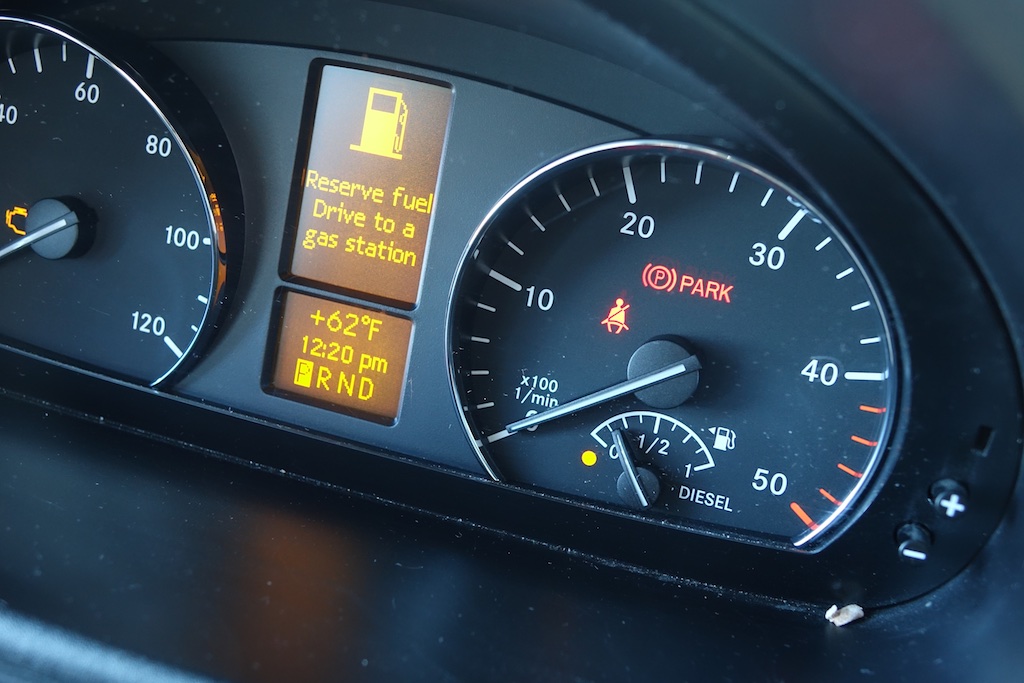 A better digital display on the Mercedes dash, plus an analog (but accurate) fuel gauge.
A better digital display on the Mercedes dash, plus an analog (but accurate) fuel gauge.
The right side steering wheel buttons let you control volume and switch modes with the new Xite GPS Infotainment system which allow you to use the steering wheel controls to handle calls and volume.
There was also one more significant change to the Sprinter and that's the service interval. This is not a typo: the first service (and subsequent ones) happens at 20,000 miles! Yes, that's the first time you change oil, too. I re-read the manual twice to make sure on that one.
The Coach
From the outside in let's take a comprehensive look at our Navion. Though our coach is an Itasca Navion model, Winnebago has now dropped the Itasca name. The only difference these days between Views and Navions is which dealer sells what name. From color to features, to price, they are now exactly the same.
Aluminum wheels. Somewhere near Holbrook, Arizona we left behind a wheel simulator (aka hubcap) a few years ago and, as any View/Navion owner learns, these things have a way of coming off, so wire ties are in order for securing them. And, for those who have lost a simulator or two, you know they're a couple of hundred dollars to replace. When we bought our first Navion the extra cost for aluminum wheels seemed like a total fluff. But this time around, not having to mess with or worry about the simulators, seemed like a small, albeit luxurious expenditure.
Full body paint. The other "who needs it?" option was full body paint. Winnebago does a very nice job with their graphics appliques over the gel coat walls and it's definitely a big gulp to consider spending over $6,000 for paint. Outside of the more upscale aesthetic of full body paint, there are two other considerations. The first is that paint can be better matched for touchup, buffed up, and doesn't oxidize over time like gel coat. The other is the equivalent of "curb appeal" in selling a home. While you won't recover your full investment cost in this upgrade, it can make a difference in a better and faster resale or trade-in.
Exterior Storage. If you want to get a good sense of how a View/Navion stacks up against a competitor's product, one of the best places to look is at the underneath storage compartments and doors. The feel and precision of the gas-strut assisted, box folded aluminum doors says it all.
Entry Door. And while we're on the subject of gas struts, let's talk about the front door. The gas strut holds it open at a 90-degree angle which now eliminates the tendency to swing in the way of the awning when it's being extended. This also eliminates the metal anchor rod we used to have to use to hold the door fully open. Adding the strut required more structural reinforcement of the door and it feels very substantial. Best yet, many View/Navion owners (including us) fought the issue of a going down the road squeak coming from the door latch. This seems to have been fixed with the new door and we've never heard a peep.
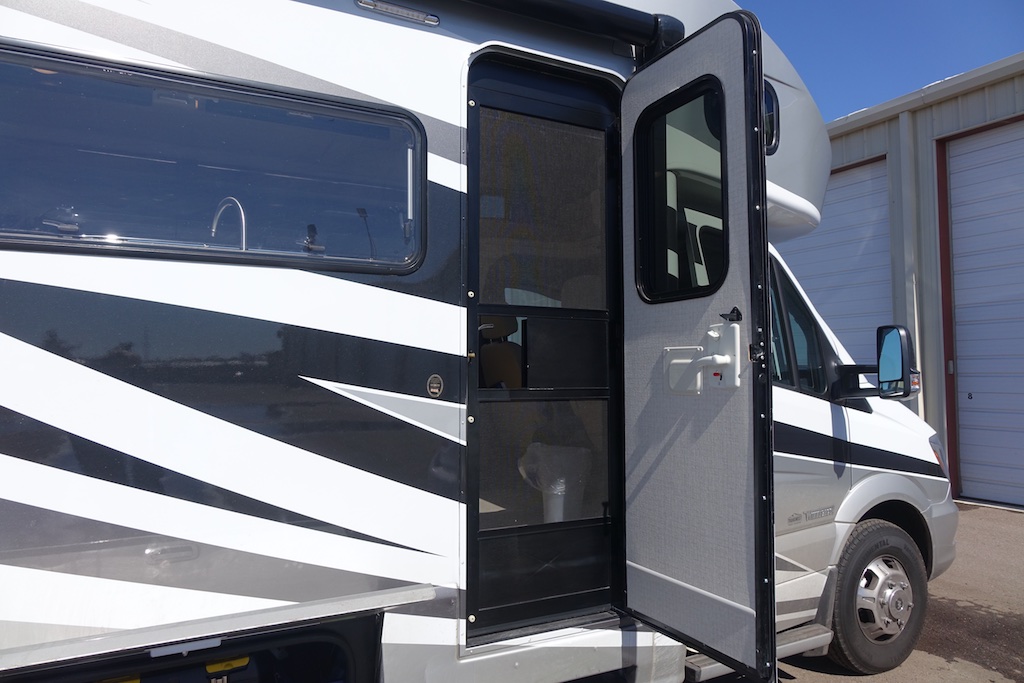 A much stronger coach door with a gas strut to hold it open.
A much stronger coach door with a gas strut to hold it open.
Awning. Before we head inside the coach there are two other new features that we really liked. The first is the outside porch light is now an LED and a very bright one at that. The awning, when extended, is also lit with blue cast LEDs (less likely to attract mosquitos) and throws a beautiful envelope of light. One warm evening in Tampa we ate outside with friends under the awning and the ambiance was pretty magical.
Floorplans. The product line has three different floorplans the G (2 slides, mid-bath, queen walk around bed in back), V (1 slide, mid-bath, twin beds in back), on and the J (1 slide, U-dinette, and corner rear bed).
The J corner bed floorplan is perhaps the most common style of floorplan found in most every RV manufacturer's smaller products. There's a reason for that. By putting the bed in the corner, you free up very valuable wall space and create a greater sense of openness in the coach and storage under the bed. In 2015 Winnebago stretched the J body style out to the 25.5' length to achieve parity with the other floorplans and, in so doing, created more space.
Storage. Compared to our V, the new J gave us a lot more storage space than we'd anticipated. Our V was pretty well packed, and when we loaded everything into the J we found a lot more - and I mean a lot more room. We're pretty disciplined about not accumulating stuff (at home and in the RV) and after two years of travel, we still feel like we have everything we need (with storage space left over).
To start with, we picked up another equally large outside storage bay on the driver's side of the rig. Our V only had one. There is storage underneath all three of the U-dinette's three seats which allowed us to bring some outside storage items, like paper towels, toilet paper, and vacuum cleaner inside.
We opted for the overhead bunk instead of the skylight profile model (which we had in our V). There are some really nice molded storage crannies under the mattress which are ideal for infrequently used items like our portable CB radio, walkie-talkies, and some extra flashlights. When parked, we liked the shelf-like space on the mattress to temporarily set clothes, maps, cameras, etc. We also stored the optional booster cushions for the two cab seats up above.
With the TV cleverly mounted on a swing-out bracket in front of an above the galley cabinet, I now have easy access to the TV electronics (we have a Dish satellite receiver and I also added an HDMI switcher and AppleTV). But beyond the electronics gear, there is plenty of room for bags of chips, bread, and a toaster.
The cabinet doors on both the galley and vanity run from the floor to the counter and, when opened, reveal a lot more accessible space. It made it much easier to see and access items. This was a huge improvement over our 2013V. The full pull-out drawers in the galley are great, but there was one suggestion I made to Winnebago and that's to deepen the thin top drawer by just about a half inch so standard silverware trays will clear. As it was, we found a great organizer which I had to slice about a quarter of an inch off with a Dremel tool to get it to fit.
The base of the corner bed lifts up effortlessly with the help of a gas strut. We have come to appreciate this feature more and more as it makes access to vertically stored wine bottles, electric space heater, and extra towels super easy to get to. The outside access to this same large compartment also allows me to move the lawn chairs in and out easily and get to all our bike and hiking gear too.
All the overhead cabinets now have positive latching hardware and, being stylish in their Italian design, good hand feel. Both of us really liked the classy look of the high gloss cabinetry which is an optional cost. Yes, yes -- we knew that there would be a little extra wiping down for fingerprints and smudges, but that has proven to be actually very minimal and we remain happy with our decision.
Moving from one floorplan to another took some figuring out where to put things. Right after we picked our Navion up from our dealer (Transwest, north of Denver), we immediately drove to a local mall and parked it right in front of the Container Store. For the next two and a half hours, we walked in and out of the store trying various organizers. Everybody packs differently, but no matter what your storage theories are, a trip to a Container Store is highly recommended.
Furniture. The centerpiece, and big deciding factor in switching to the J floorplan is the beyond spectacular U-shaped dinette. I talked about the great storage under the seats, but the seats themselves are worth mentioning. They are built like residential furniture with springs underneath the padding and Ultraleather's Primera covering. What this means is, unlike foam blocks, the long-term sitting comfort is much better. The Winnebago design engineers also came up with a fantastic fold-out footrest/ottoman solution. Like the best loungers, the footrest tilts slightly forward for maximum comfort.
One evening we actually had eight friends wrapped around the dinette for some apres dinner wine and conversation. For dinner, it does just fine for four.
Watching the new Insignia 28" TV with our feet up proved to be an extraordinarily comfortable position. Our enjoyment was enhanced by the placement of the TV speakers right above our heads which created a surprisingly good home theater effect.
A rectangular table swivels and locks on a center post. And boy, do we swivel it throughout the evening as for dinner we'll lock it down where Terry and I sit across from each other while dining. Later, when watching TV, reading, or using our laptops with our feet up, we'll turn the table ninety degrees for more sitting width and a great place to set a mug or glass.
A furniture option we chose was the "booster seats" for the driver and passenger seats. For extended stays, we rotate the seats in toward the coach and with the boosters, find them to be exceptionally comfortable for reading, watching TV, or conversing.
After a year a half we finally had a guest for the top bunk (our adult son). We purchased a lightweight sleeping bag from REI which stores easily under the back dinette seat. He found it to be very comfortable for sleeping with a little extra roof height and a reading lamp. We've never turned the dinette into a bed. However, we experiment by setting it up once and found the process easy to do.
Our single biggest concern about the J floorplan was dealing with a corner bed. All the worries were there: hard to make, hard to get into, too narrow, and what if one needs to get up in the middle of the night. Yep, that one made us nervous. Well, the very good news was that, for us, none of these worries came true (big sigh of relief).
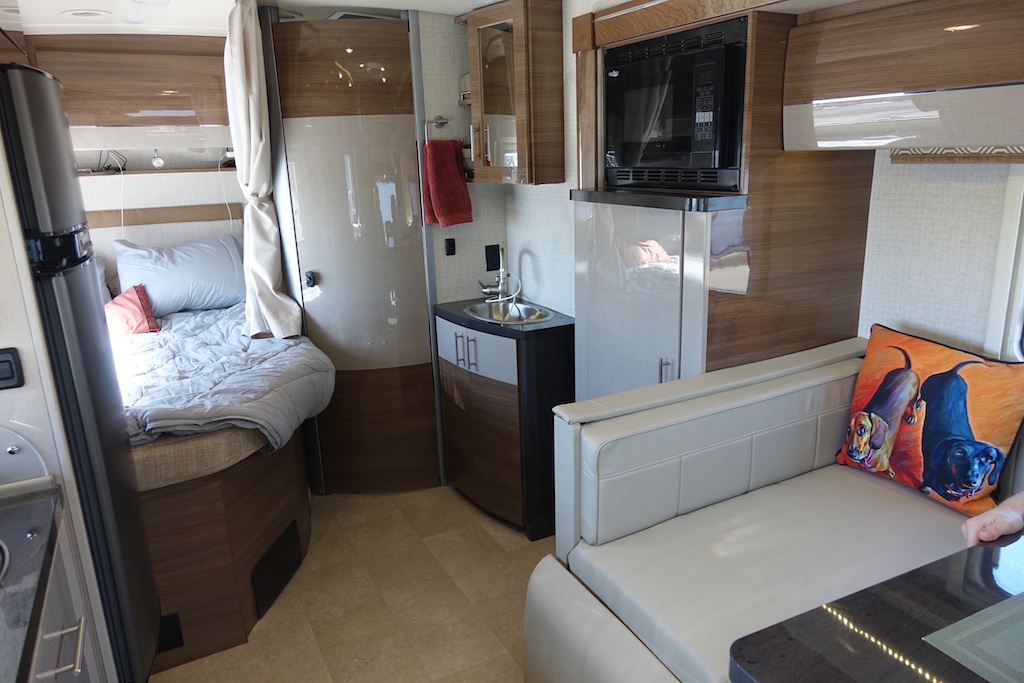 The corner bed worked for us, especially with the convenience of a Travasak (no longer manufactured, but similar to the RV Superbag). For more information on bedding click here for a more in-depth story. The shelf above the bed was a great place to place our iPads and phones for charging while we were sleeping. Under-bed storage access with a gas strut lift made lifting the bed very easy.
The corner bed worked for us, especially with the convenience of a Travasak (no longer manufactured, but similar to the RV Superbag). For more information on bedding click here for a more in-depth story. The shelf above the bed was a great place to place our iPads and phones for charging while we were sleeping. Under-bed storage access with a gas strut lift made lifting the bed very easy.
First of all, we solved the bed making with a combination comforter and sheet system that is essentially a fancy sleeping bag. I'm 5' 11" and it was great not having my feet touch a bulkhead wall like they did in our V because the J bed is 80" long. As I usually get into bed after Terry is asleep (on the shorter inside position), I barely disturb her as I crawl into the outside position. At home, we sleep on a queen sized bed and the J is more like a super full sized mattress, but after our first three-week trip, we both concluded that the bed was both comfortable and easy to deal with. Our home mattress is a TempurPedic and while the standard Winnebago mattress isn't that fancy, the quality of the foam and additional tufting was a noticeable improvement over pure foam slabs. Newer models can be equipped with the Froli spring system which are some unique lightweight spring panels that add another level of comfort.
Electrical power. As we did with our first Navion, we ordered the more expensive Onan diesel generator. With a $4,000 dollar higher cost than the LP version, it's a point of lively debate among View/Navion owners. I'm afraid I cannot offer any perfect wisdom on which is better. For us, we like the convenience of being able to tank up at any filling station with diesel instead of the less convenient process of finding LP. If you don't anticipate heavy generator use, the LP version is probably the way to go. A significant majority of View/Navions are sold with LP generators. Having tested both, the sound level and vibration are essentially the same. One surprise to me is that there is a distinct smell from the LP exhaust that can be equally annoying inside the coach if a breeze is blowing in the wrong direction or you're hemmed in by two semis at a truck stop.
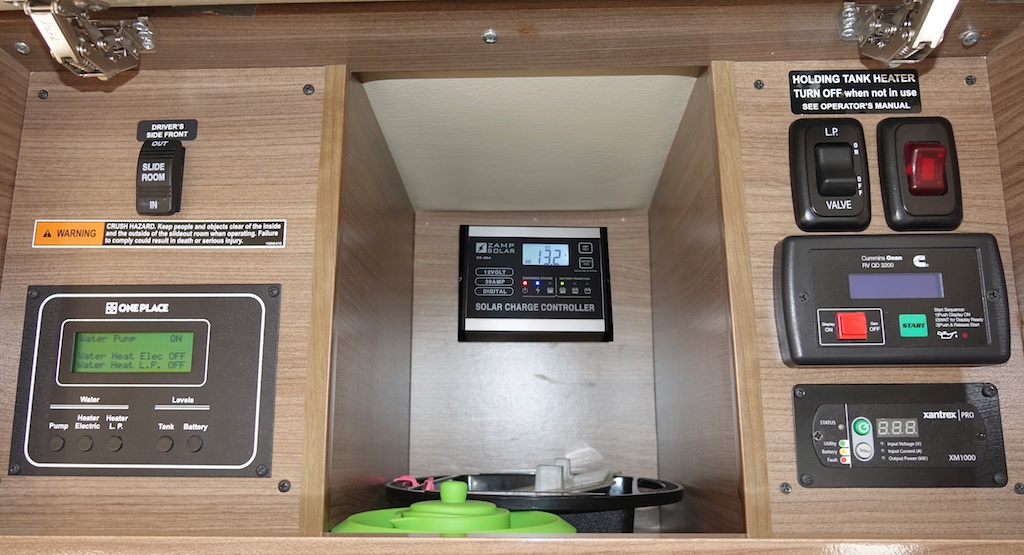 Tucked away behind a cabinet door are the coach controls and the Zamp Solar monitoring panel.
Tucked away behind a cabinet door are the coach controls and the Zamp Solar monitoring panel.
Many View/Navion owners have added solar to their rigs and that was another special option we had Winnebago's customer service install. They went with a Zamp Solar 150 watt, 30 Amp single panel system. The charger works, even in open shade or overcast (albeit slowly), and you can always see the rate of gain as the panel is pushing electrons to the batteries. This is a truly set-it-and-forget-it technology that quietly does its job. In a deeper read of Zamp's information, the company explains that the auxiliary solar charge extends battery life by reducing the deep discharge cycle of the batteries.
Lighting. Of course, all RV manufacturers have switched over to energy efficient LED lighting, but Winnebago's also taken advantage of using LED lighting strips as part of their interior design with indirect accent lighting. This creates a very warm pleasing residential feel in the evenings and the word "classy" certainly seems to be the best descriptor. One change owners of older View/Navion units will notice is there are no labels on the light switches. At first, I thought this was an oversight, then it was pointed out to me that we don't label our lights at home. Good point. We quickly got used to knowing which switch was for what. The newest models now use a very good halo light that also has a dimming ability.
Electronics. I have reviewed the latest Xite Infotainment GPS in-dash option in a separate review. Of course, the first question most folks will have is the upgrade option really worth it. In a word: yes. This is a specially designed product for Winnebago that has enough compelling features, including the Rand McNally RV GPS software, to make it a better choice than other aftermarket solutions. We used it a lot and, once we took the time to really learn it's many features, really appreciated having it.
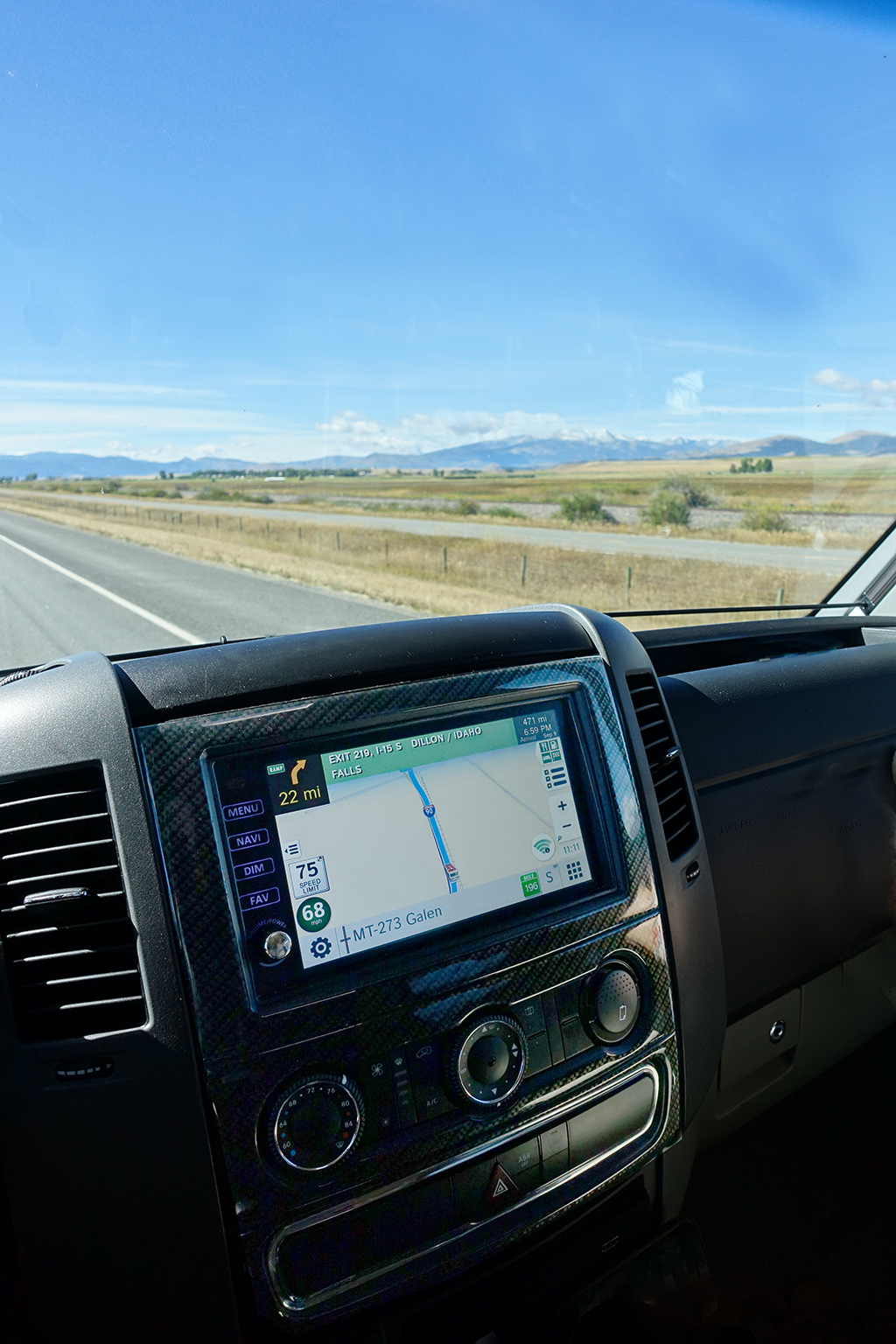 The Xite Infotainment GPS system uses Rand McNally's GPS software which does a great job of getting us to where we wanted to go. Units ordered in with this option now get the awesome 9" screen. Sorry - no upgrades for older coaches.
The Xite Infotainment GPS system uses Rand McNally's GPS software which does a great job of getting us to where we wanted to go. Units ordered in with this option now get the awesome 9" screen. Sorry - no upgrades for older coaches.
Built into the galley cabinet is the Jensen house sound system that controls speakers inside and outside the coach. Winnebago has clearly upgraded the interior speakers and we really enjoyed the audio for both music and television. When we streamed the final episodes of "Game of Thrones" to get caught up to the new season, the sound was really theatrical and, the placement of the speakers over our heads ensured that no British-accented dialogue was missed.
The Jensen also now allows you to stream Bluetooth music which I often do with my iPhone and MacBook. It has a regular DVD player built-in (not Blu-ray) which we've never used as we prefer streaming shows that we've downloaded onto our iPad.. Now, I'm not a persnickety audiophile, but I can and do appreciate the good clean sound. And in that regard, the Jensen is a very middling performer. Great? No. Good enough for 95% of owners. Absolutely.
The main TV in the front of the coach is a nice looking Insignia flat screen with very decent angular viewing. The only drawback is that it's a 120-volt screen, but that's not a big issue as it's plugged into an inverter driven outlet so you can run it off of house batteries if you're dry camping and don't want to run your generator.
One of our special changes was to have customer service to run an HDMI cable from the front cabinet, where my satellite box is located, back to the bedroom TV. In standard installations the high def signal coming from the satellite got turned into a lower def composite signal (less sharp, cropped picture). Having a cable pulled (next to impossible to run after the coach is built) allowed me to not only have hi-def satellite on both screens, but also hi-def video streaming from our iPad or Apple TV box.
Galley. To create more living space, the new J floorplan cleverly places the microwave above the closet on the slideout side. We have found this to be a very convenient arrangement that helps eliminate traffic congestion during meal preparation. Though galley counter space is limited, the glass cover over the Dometic 2-burner stove definitely helps. We bought an induction cooktop to use when we're hooked up to shore power and, while traveling it sits solidly on the glass burner cover. We found that keeping one cover on one side of the dual sink also added a little more work surface. In 2014 Winnebago switched from wood sink covers (decorative yet prone to break) to a hard plastic which is a much better product.
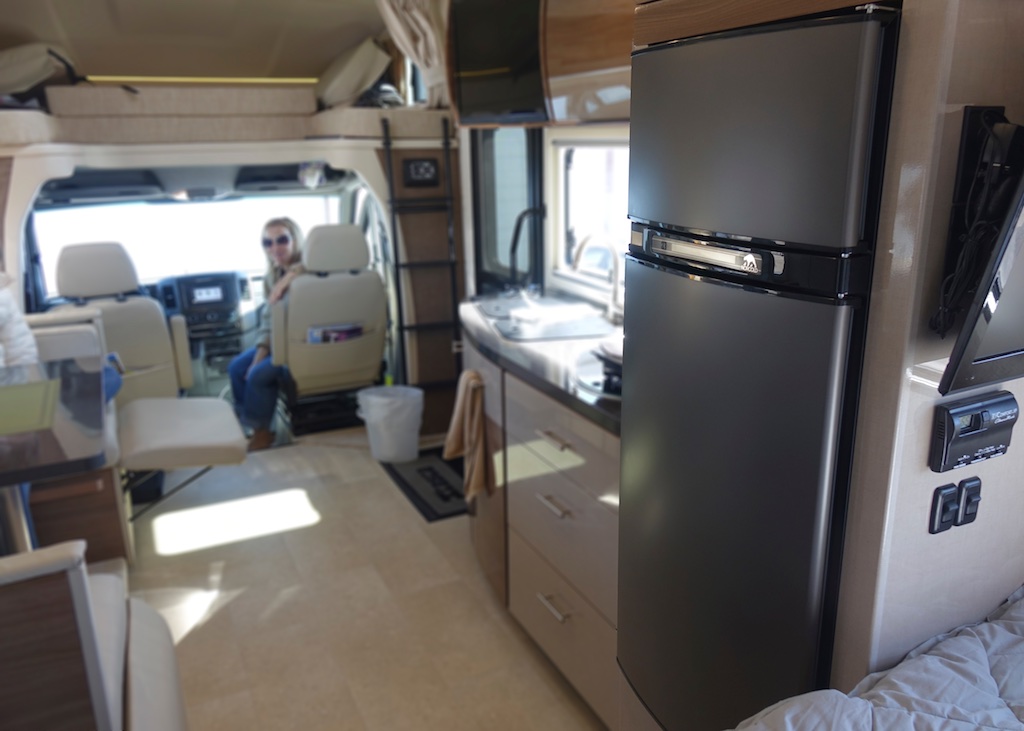 It's a lot more convenient having a separate freezer door with the Norcold.
It's a lot more convenient having a separate freezer door with the Norcold.
The hands-down winning upgrade in the galley is the switch to a Norcold refrigerator instead of the Dometic. We found the Norcold to be far and away a better product. First of all, it did a much better job of switching between power sources. As we disconnected from campground 120V hookups and traveled down the road, it automatically switched to gas. We really appreciated the separate freezer door, unlike the Dometic where you had to open the whole refrigerator door to get to the awkward fold-down freezer compartment door. Finally, the Norcold got colder and held temperature much better than the Dometic which always struggled. We were shocked when a can of pop actually froze on the top shelf of the fridge and found that we could maintain a cold temperature at the number 3 (out of 5) setting. This also meant that ice cubes would freeze in a few hours, versus overnight.
Winnebago is starting to phase in all-electric compressor drive refrigerators that don't require much electricity when you're dry camping. These kinds of refrigerators cool down quicker, hold temperature better, and should perform better at high altitude.
Ventilation. We had the Dometic power skylight on our V and were happy to have it in the J. It's something we enjoy and use a lot. Winnebago made a pretty bold choice to remove a vent over the two-burner stovetop. For exhausting cooking smells and vapor they added a fairly quiet fan, mid-coach, that does a fairly effective job. It's not as good an over the stove vent hood, but we're pleased with how well it works.
The ceiling AC/Heat unit worked as expected with the added bonus of a little more controllability with air vents also on the unit's ceiling cover plate.
The standard Suburban gas forced air furnace doesn't offer up any surprises and worked as expected. However, clearly attention was paid to installing it in a way that helped decrease the fan noise -- not by a lot, but it definitely was quieter than our previous V.
Hot water. Our Navion came with a standard 6-gallon hot water heater, but in 2017 we replaced it with the same ultra-efficient Truma on-demand heater Winnebago now offers. That was a great upgrade. Here's a much fuller review of the Truma AquaGo that details our experience. Along with the Truma, the interior plumbing of current models has been changed so you get nearly instant hot water in the shower meaning that when you're boondocking you don't waste much water coming up to temperature. Brilliant!
Another special feature we had installed by Winnebago's customer service was the new Maxxfan Deluxe made by MaxxAir. It was installed in place of the normal bathroom vent. As we expected, it served as both a bathroom vent and a whole-coach high capacity air exhaust fan. It's quiet and super controllable. We mounted the IR remote control in the bathroom where you could access it from a, uh, sitting position if you didn't plan ahead. The fan's speeds are adjustable and can be easily programmed to open up to exhaust air at a predetermined temperature. When the fan starts the skylight cover automatically raises and is designed to keep leaves, twigs, and insects out when open. This is one impressive product and the good news is for existing View/Navion owners, it installs in the standard vent dimensions so it should be fairly straightforward to add as an aftermarket upgrade. Fantastic product.
Windows. So let me borrow the words from the last paragraph: excited, impressive, fantastic and let me add the word awesome to the list. What am I describing? The Seitz acrylic windows that Winnebago offers as an option on the Via/Reyo and was happy try out in our Navion.
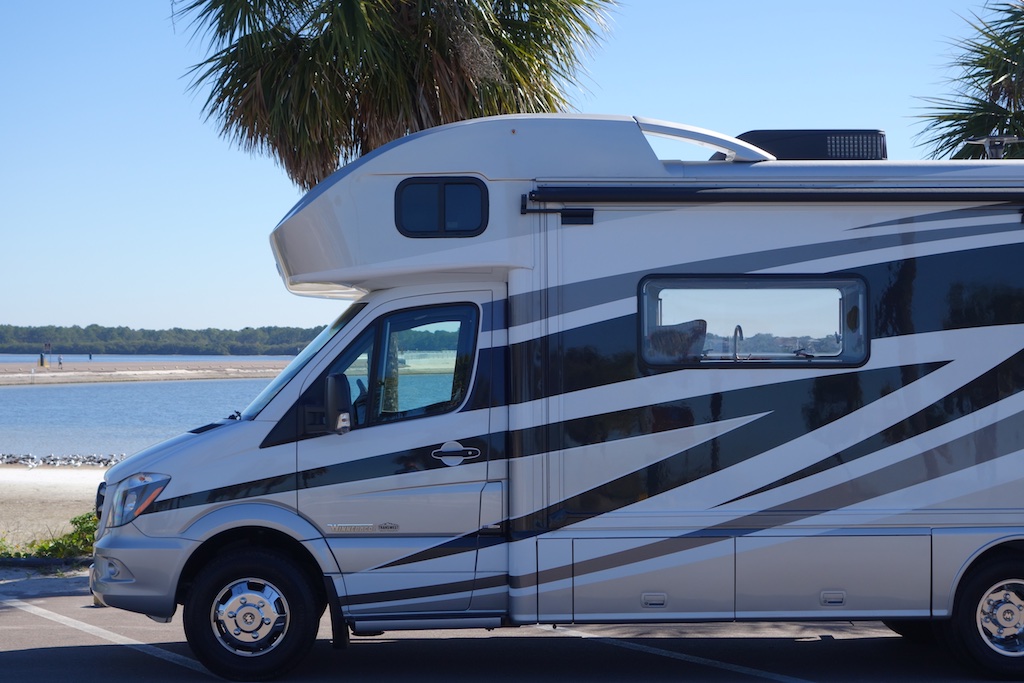 With no middle frame dividers and retractable screens, the Seitz acrylic windows offer a wide, bright, panoramic view.
With no middle frame dividers and retractable screens, the Seitz acrylic windows offer a wide, bright, panoramic view.
These windows are double glazed acrylics with an integrated screen and blind system. We were keen to try them as we hoped they would offer better insulation when we stay in colder climates. It's my hope Winnebago will make this option available to future View/Navion owners.
They're quiet. They don't rattle. They insulate against cold (drafts) exceptionally well. They cut down on outside evening noise (Walmart parking lot). They offer excellent light and privacy control. And, in a big thunderstorm downpour in the Florida Keys that woke us up at 2 AM, I checked to see if any rain was coming in with our bedroom window tilted open. Nope. Not a drop.
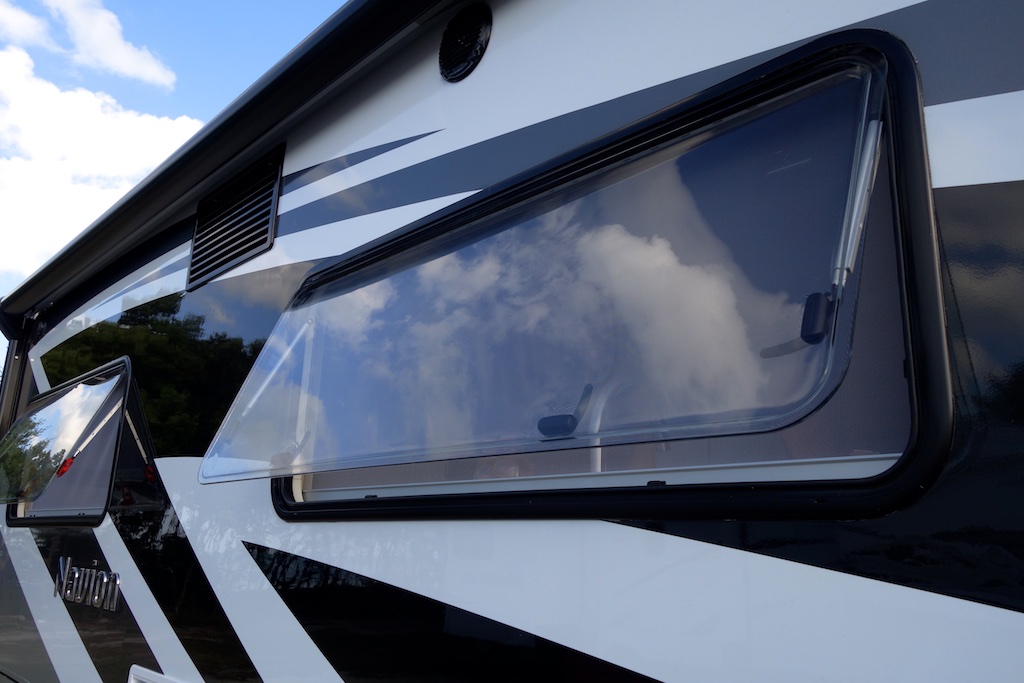 Good ventilation with the built-in screens in place were perfect to protect against rain and bugs in the Florida Keys.
Good ventilation with the built-in screens in place were perfect to protect against rain and bugs in the Florida Keys.
After two years of use our windows look great (we don't use ammonia-based cleaning products, a little vinegar and water are fine). Zero regrets on that choice.
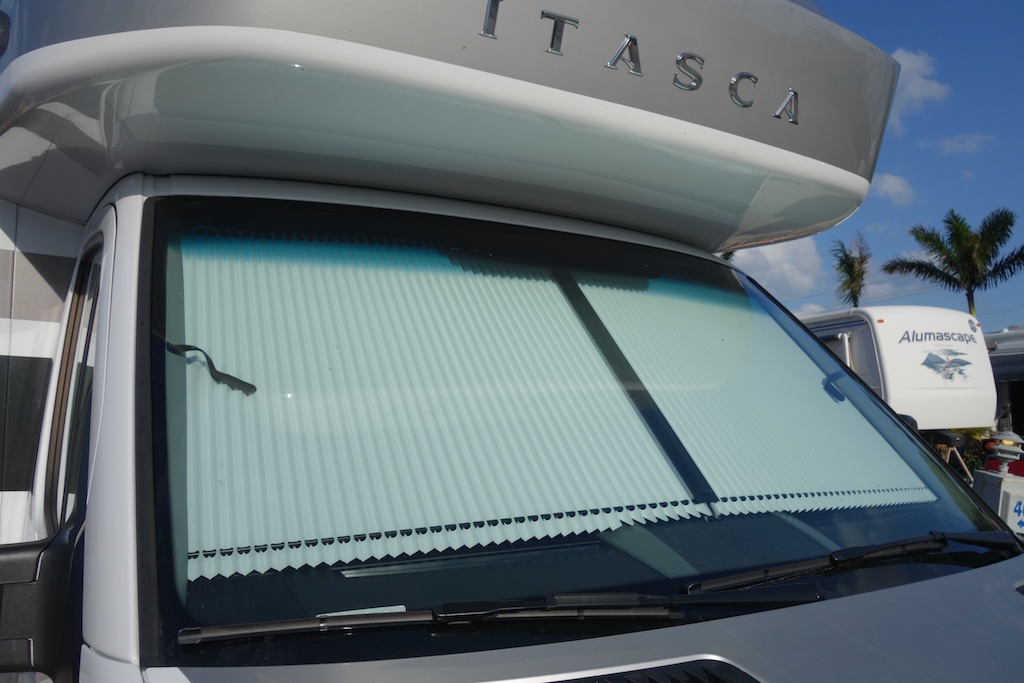 The Remis shades not only offer privacy, but help keep the coach cool when parked in the sun.
The Remis shades not only offer privacy, but help keep the coach cool when parked in the sun.
Comments
Comments on this post are moderated, so they will not appear instantly. All relevant questions and helpful notes are welcome! If you have a service inquiry or question related to your RV, please reach out to the customer care team directly using the phone numbers or contact form on this page .
